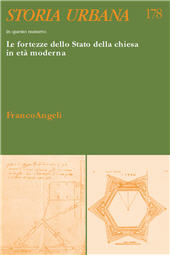La fortezza Pia di Ascoli Piceno sul Colle dell'Annunziata : da presidio territoriale a struttura "alla moderna"
45-73 p.
La penisola ascolana compresa fra i fiumi Tronto e Castellano si presenta fin dalle origini come un luogo dalle straordinarie difese naturali. Ma se i lati sud, est e nord, percorsi dai fiumi e dalla loro confluenza, erano protetti da alte e ripide sponde, il versante ovest, approdo della via Salaria romana, rimaneva esposto a possibili attacchi dagli Appennini. Già nell'antichità, la città dovette quindi dotarsi di una cinta muraria che, particolarmente verso questa direzione, ne garantisse la difesa. La cortina ovest descrive un tratto rettilineo da nord a sud, risalendo il ripido Colle dell'Annunziata, punto più alto di Ascoli. Qui fu realizzato un presidio, il quale, indissolubilmente legato alla cintura difensiva, la modificò nel tempo, divenendo infine l'attuale struttura "alla moderna" della fortezza Pia. Questa fu attiva dalla metà del XVI alla metà del XIX secolo ma già in epoca medievale la vetta del Colle doveva essere dotata di una compagine delle mura, adeguata a ospitare
una guarnigione. La lunga realizzazione di tale struttura strategica non fu quindi soltanto un episodio architettonico ma si intersecò a più riprese con la storia urbana. La fortezza Pia rappresenta l'esito di una sovrascrittura prolungata e, nella fase conclusiva, non priva di anomalie, specie in rapporto ai canoni della trattatistica cinquecentesca sulla fortezza bastionata. Questo testo ne indaga i principali passaggi soffermandosi in particolare sulla configurazione "alla moderna", momento che ha cambiato la fisionomia delle mura e della stessa città di Ascoli. [Testo dell'editore]
The Ascoli Piceno peninsula, situated between the Tronto and Castellano rivers, has historically been recognised for its remarkable natural fortifications. However, should the south, east and north sides, intersected by the rivers and their confluence, be fortified by high and steep banks, the western side, the location of the Roman Via Salaria, would remain vulnerable to potential incursions from the Apennines. Consequently, in antiquity, the city was compelled to fortify itself with a defensive barrier, particularly in this direction, to ensure its security. The western curtain is defined by a linear expanse extending from north to south, ascending the precipitous Annunziata Hill, which attains the highest point in Ascoli. A garrison was erected at this location, which, inextricably linked to the defensive belt, underwent modification over time, ultimately resulting in the current "modern" structure of the Pia Fortress. This period of activity extended from the mid-16th century to
the mid-19th century; however, even in the Middle Ages, the top of the hill was deemed suitable for the establishment of a garrison. The protracted construction of this strategic structure was therefore not solely an architectural episode, but rather intersected on multiple occasions with the urban history. The Pia Fortress is indicative of the outcome of a prolonged overwriting process, and, in the final phase, exhibits anomalies, particularly with regard to the canons of the sixteenth-century treatises on the bastioned fortress. The present article investigates the main passages, focusing in particular on the "modern" configuration, a moment that changed the physiognomy of the walls and of the city of Ascoli itself. [Publisher's text]
Fait partie de
Storia urbana : rivista di studi sulle trasformazioni della città e del territorio in età moderna : 178, 2, 2024-
Articles du même numéro (disponibles individuellement)
-
Informations
Code DOI : 10.3280/SU2024-178003
ISSN: 1972-5523
KEYWORDS
- Ascoli Piceno Fortezza Pia Fortezze "alla moderna" Cinta muraria Architettura Militare
- Ascoli Piceno, Pia Fortress, "Alla Moderna" fortress, City Wall, Military Architecture


